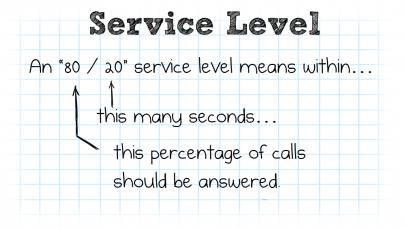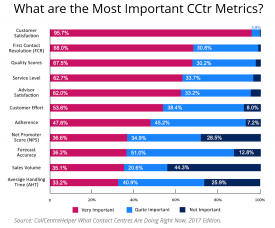In the wide world of call center metrics, “service level” has always held a special place. It gives the industry a universally understood way to talk about how quickly calls are answered by agents. Its origins go back over 5 decades, to the earliest days of call centers.
The longevity of service level is astonishing when one considers the enormous changes that have occurred in customer service technology over the last few decades. Even more astonishing is that most call centers would name the same target value for that metric: the magical “80/20”.
Now – finally – this dominance may be fading. Contact centers are realizing more and more that adhering too closely to this one metric may not yield optimal results.
Definitions
First, a quick review of the definition: Service level is always given as a pair of numbers: a percentage value and a time value in seconds. Thus, an “80/20″ service level means 80% of calls answered in 20 seconds. As mentioned above, that exact combination is considered by many to be an industry standard.
One would hope that this standard is based on careful analysis, but in reality, it appears 80/20 was arbitrarily chosen in the early days of call center technology. The original logic behind it is lost to time. (See Why 80/20 is Probably the Wrong Service Level for your Call Center.)
Seeing the Bigger Picture
The case against worshipping service level has been made by many contact center analysts and industry veterans. Most of the complaints boil down to the idea that, if too much attention is focused on optimizing for this metric, other facets of the call center can suffer.
Harvard Business Review put it succinctly: “Instead of worrying about typical customer satisfaction measures, such as share of wallet and net promoter scores, organizations should look at the number of new value-adding service ideas put into practice. It’s not that conventional metrics are unimportant, the researchers say, but because they are ‘lagging indicators’ they can bog down efforts to achieve rapid, dramatic change.”
It seems call center managers are taking this advice to heart. In a recent report by Call Centre Helper, the researchers asked participants to rank the importance of different metrics in their operation. Surprisingly, service level is in 4th place!
Here is some further reading from our blog:
- Is an 80/20 Service Level Your Call Center’s North Star?
- Why 80/20 is Probably the Wrong Service Level for Your Call Center
- Call Center Metrics: 4 Pitfalls You Need to Avoid [Whitepaper]
Keeping Service Level in Context
To be clear, no one is saying that service level shouldn’t be measured, and that a target value shouldn’t be set. The advice here is against making that target your primary goal.
Assembling a broader picture for managing performance in your call center is a big and complicated topic. To tackle it properly, we recommend these books:
- Optimize by Patrick Botz and Dick Bucci
- Call Center Management on Fast Forward by Brad Cleveland
- Call Center Rocket Science by Randy Rubingh
To round out your perspective, you should also read some books that place the call center in the larger context of customer service. We published a list of 6 excellent books in that category here: Top Customer Experience Books You Need to Read.

Discover the Contact Center Trends That Matter in 2024
Dig into industry trends and discover the changes that matter to your business in the year ahead.

